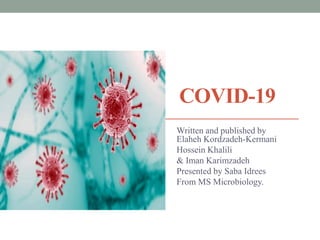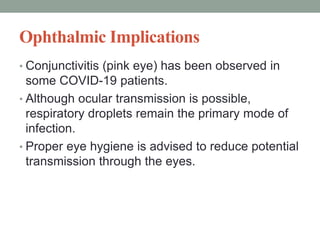Covid 19 basic
- 1. COVID-19 Written and published by Elaheh Kordzadeh-Kermani Hossein Khalili & Iman Karimzadeh Presented by Saba Idrees From MS Microbiology.
- 3. Introduction • In December 2019, a novel coronavirus (initially named 2019-nCov) emerged in Wuhan, China, causing an outbreak of viral pneumonia. • Later named SARS-CoV-2 due to structural similarities with SARS-CoV(2003 outbreak). • Rapid global spread, with significant morbidity and mortality. • Presentation aims to review clinical characteristics, pathogenesis, and ongoing research efforts.
- 4. Key Facts and Figures • As of July 22, 2020: • Over 14.9 million confirmed cases worldwide. • More than 610,000 deaths attributed to COVID-19. • Rapid spread across continents, raising global concern. • Human-to-human transmission via respiratory droplets, aerosols, direct contact, and possibly fecal- oral route.
- 5. Clinical Manifestations and Complications • Common symptoms: fever, cough, fatigue, anorexia, dyspnea, myalgia. • Atypical presentations: lack of fever, radiological abnormalities • Asymptomatic carriers facilitate transmission. • Complications: respiratory system involvement (ARDS), cardiovascular impact (hypertension, heart disease), and more.
- 6. Pathogenesis and Mechanisms • ACE 2 receptor: key for viral entry into host cells. • SARS-CoV-2 binds ACE 2 receptors with higher affinity than SARS-CoV. • ACE 2/angiotensin (1–7) axis disturbance linked to clinical features • Evidence of ACE 2 expression correlation with age, sex, and organ involvement. • Other potential entry routes: CD 147 receptors, ongoing research.
- 7. Ongoing Research and Management Strategies • Ongoing efforts to develop vaccines: adenovirus- based, mRNA-based, and ChAdOx1 vaccine trials. • Therapeutic approaches: initial use of chloroquine, hydroxychloroquine; remdesivir's controversial efficacy. • Clinical manifestations influencing outcomes: age, comorbidities, immunosuppressive therapies. • Further research crucial for improved treatment and prevention strategies.
- 8. Neurological Involvement • COVID-19 has shown to have neurological effects, including anosmia (loss of smell) and ageusia (loss of taste). • Some patients experience neurological symptoms like headaches, dizziness, and confusion. • Reports of more severe neurological complications like encephalitis and Guillain-Barré syndrome have also emerged.
- 10. Respiratory Implications • Severe cases of COVID-19 often lead to acute respiratory distress syndrome (ARDS). • ARDS results from an excessive immune response leading to lung inflammation and fluid accumulation. • Mechanical ventilation is often required to manage severe respiratory distress.
- 12. Gastrointestinal Involvement • Digestive symptoms such as nausea, vomiting, and diarrhea have been reported. • ACE 2 receptors in the gastrointestinal tract may facilitate viral entry and replication. • Gastrointestinal symptoms can occur before or in the absence of respiratory symptoms.
- 13. Ophthalmic Implications • Conjunctivitis (pink eye) has been observed in some COVID-19 patients. • Although ocular transmission is possible, respiratory droplets remain the primary mode of infection. • Proper eye hygiene is advised to reduce potential transmission through the eyes.
- 15. Psychological Impact • COVID-19 has led to increased stress, anxiety, and depression globally. • Social isolation, uncertainty, and fear of the virus contribute to psychological distress. • Healthcare providers and vulnerable populations are particularly susceptible to psychological strain.
- 16. Reproductive System • Limited evidence on the impact of COVID-19 on the reproductive system. • Concerns exist about potential effects on fertility and pregnancy outcomes. • Research is ongoing to understand the virus's impact on reproductive health.
- 17. Long COVID • Some individuals experience persistent symptoms long after recovering from acute COVID-19. • Symptoms include fatigue, shortness of breath, cognitive issues, and more. • Long COVID's exact mechanism and management are still being studied.
- 18. Pediatric Implications • Children usually experience milder symptoms compared to adults. • Multisystem Inflammatory Syndrome in Children (MIS-C) is a rare but severe complication linked to COVID-19. • Pediatric patients require careful monitoring and follow-up to detect any long-term effects.
- 19. Vaccination and Immunity • COVID-19 vaccines have been developed to provide immunity against the virus. • Vaccination efforts aim to reduce severe cases, hospitalizations, and deaths. • Variants of the virus may impact vaccine effectiveness and require ongoing research.
- 20. Public Health Measures • Preventive measures like mask-wearing, hand hygiene, and social distancing remain crucial. • Public health campaigns promote vaccination and adherence to guidelines. • Global collaboration and research continue to inform strategies for pandemic control.
- 21. Reproductive System & COVID- 19 • Limited data on COVID-19's effects on pregnancy. • Increased risk of miscarriage, preterm delivery, and growth restriction. • Observations of preeclampsia-like symptoms. • ACE 2 receptors in reproductive tissues might facilitate viral entry.
- 22. Gastrointestinal Involvement • 2-10% of COVID-19 patients experience GI symptoms. • Diarrhea and vomiting as initial presentations. • ACE 2 receptors in GI tract epithelial cells. • Viral invasion and disturbance in RAS system linked to GI symptoms.
- 23. Neuromuscular Complications • Neurological symptoms in 36% of COVID-19 patients. • CNS symptoms linked to olfactory bulb route. • Skeletal muscle injury in severe cases. • Rhabdomyolysis and Guillain-Barre syndrome reported.
- 24. Central Nervous System Impact • 88% of severe cases display neurologic manifestations. • Neuroinvasive potential of SARS-CoV-2. • CNS entry through systemic circulation or neuronal pathway. • COVID-19-associated acute ischemic stroke reported.
- 25. Ocular Involvement • SARS-CoV detected in tear samples. • Possible conjunctivitis via droplet inoculation. • Ocular symptoms in 2-32% of cases. • Conjunctival swabs positive for SARS-CoV-2.
- 26. Skin Involvement • Cutaneous changes less common. • Skin conditions related to protective measures. • Reports of skin rash with petechiae. • Erythematous rash, urticaria, and vesicles observed.
- 27. Multiorgan Failure • Dysregulated immune response in CRS. • Multiorgan failure, respiratory, and heart failure. • Secondary hemophagocytic lymphohistiocytosis (sHLH). • Cytokine elevation and cytopenia in PIMS-TS.
- 29. Kawasaki-like Syndrome • Kawasaki-like syndrome in pediatric patients. • Named Pediatric Inflammatory Multisystem Syndrome Temporally associated with SARS-CoV-2 (PIMS-TS) and Multisystem Inflammatory Syndrome in children (MIS-C). • Hyper inflammatory syndrome with various symptoms. • Link to antibody-dependent enhancement and hyper stimulated cytokine release.
- 30. Conclusion & Future Perspectives • Respiratory system most commonly affected. • Other systems involved with varying severity. • Electrolyte imbalances and inflammatory markers predict outcomes. • ACE 2 receptor role and mutation concerns. • Immune dysregulation and possible interventions.
- 31. References • 1. Zhou P, Yang X-L, Wang X-G et al. A pneumonia outbreak associated with a new coronavirus of probable bat origin. Nature 579(7798), 270–273 (2020). • 2. World Health Organization. Coronavirus disease 2019 (COVID-19) situation report. (2020). http://www.who.int/Docs/DefaultSource/Coronaviruse/Situation- Reports/20200402-Sitrep-73-Covid-19.Pdf?Sfvrsn=5ae25bc7 4%20CDC-SRaF • 3. Xiao F, Tang M, Zheng X, Liu Y, Li X, Shan H. Evidence for gastrointestinal infection of SARS-CoV-2. Gastroenterology 158(6), 1831–1833. e1833 (2020). • 4. Centers for disease control and prevention. Symptoms of coronavirus. (2020). http://www.cdc.gov/coronavirus/2019- ncov/symptoms-testing/symptoms.html • 5. Guan W-J, Ni Z-Y, Hu Y et al. Clinical characteristics of coronavirus disease 2019 in China. N. Engl. J. Med. 382(18), 1708–1720 (2020).






























